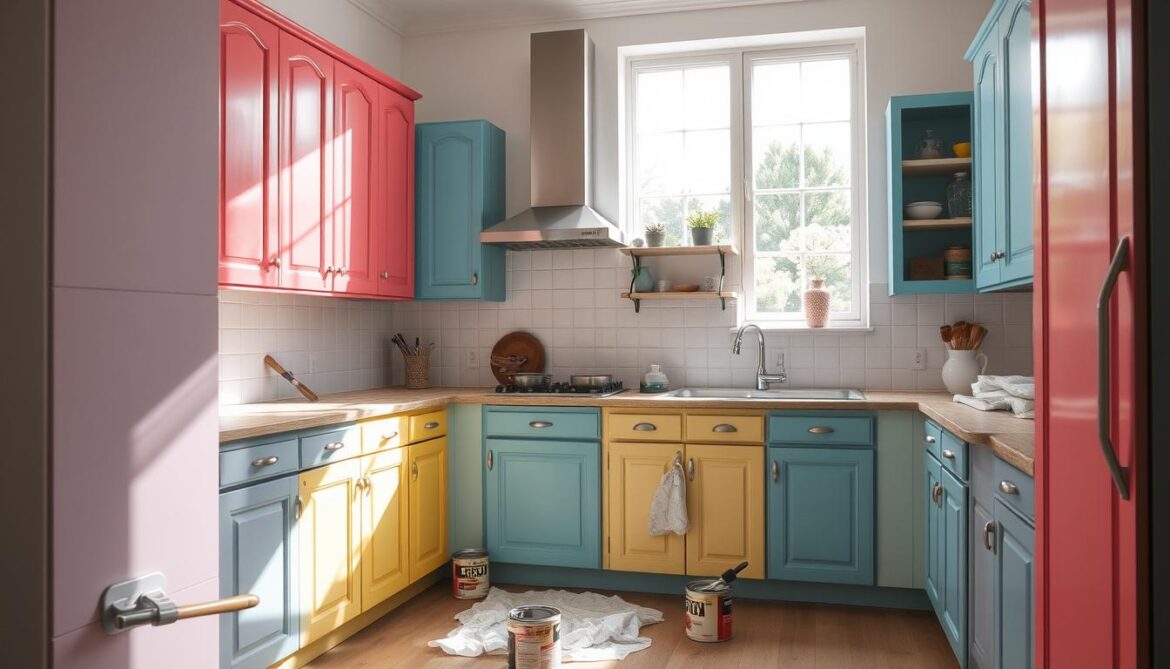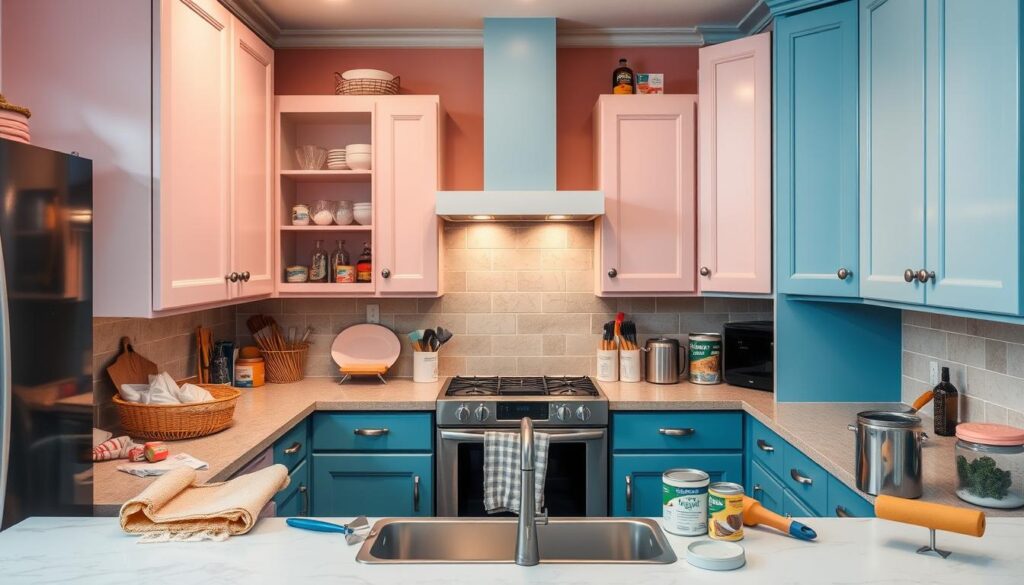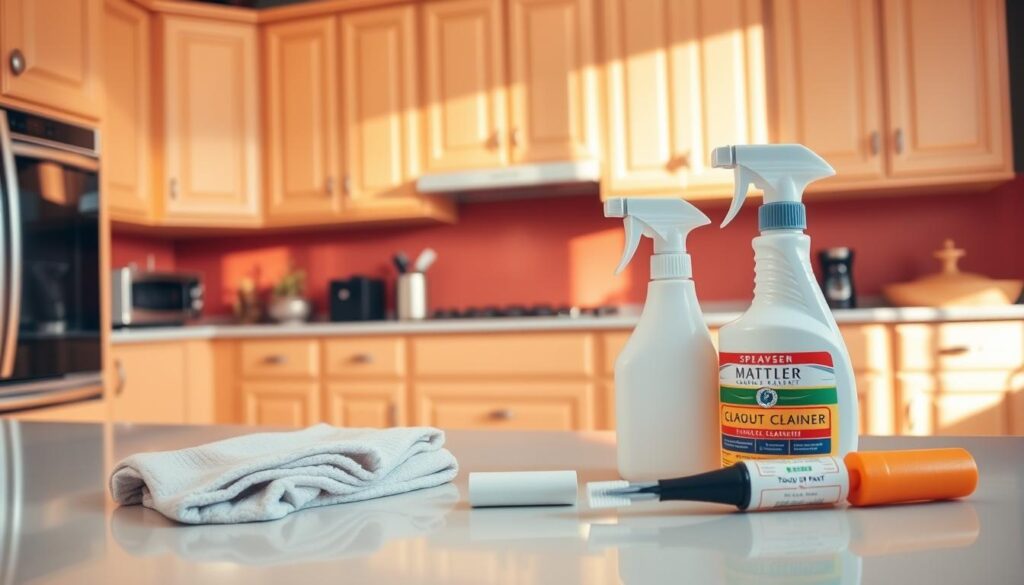is a great place to start. Painting your kitchen cabinets can make your space feel new and fresh. It’s amazing how a simple paint job can change your kitchen’s vibe, and you can do it yourself.
Doing this project yourself can save you money and give you a sense of pride. Painting your cabinets is easy once you know the steps. This guide will walk you through the process, from getting ready to finishing up. You’ll see how it can make your kitchen look better.
Introduction to DIY Kitchen Cabinet Painting
Cabinet painting is a fantastic way to refresh your kitchen. It can change your kitchen’s look and is budget-friendly. Painting your cabinets yourself saves a lot of money compared to hiring someone.
DIY cabinet painting lets you pick your colors and finishes. You’ll also feel proud of your work. Plus, a good paint job can make your home more valuable.
Benefits of DIY Painting
- Cost savings: DIY cabinet painting can save you up to 50% of the cost of hiring a professional.
- Customization: With DIY cabinet painting, you can choose from a wide range of colors and finishes to match your unique style.
- Sense of accomplishment: Completing a DIY cabinet painting project can give you a sense of pride and satisfaction.
Cost Comparison: DIY vs. Professional
| Option | Cost |
|---|---|
| DIY cabinet painting | $200-$500 |
| Professional cabinet painting | $1,000-$2,500 |
DIY cabinet painting is much cheaper. With the right tools and patience, you can get great results without spending a lot.
Choosing the Right Paint for Your Kitchen Cabinets
Choosing the right paint for cabinet painting is key for a lasting finish. There are many paints to pick from. Think about durability, how easy it is to apply, and clean-up needs.
There are mainly two types of paint: oil-based and latex. Oil-based paints last long and look glossy but are hard to work with and have strong smells. Latex paints are water-based, easy to clean, and smell less but might not last as long.
Types of Paint: Oil-Based vs. Latex
- Oil-based paints: durable, glossy finish, but challenging to work with and strong fumes
- Latex paints: water-based, easy clean-up, less odor, but may not be as durable
Best Brands for Cabinet Painting
Top brands for cabinet painting include Benjamin Moore, Sherwin-Williams, and Valspar. These brands offer quality paints for cabinets. They consider coverage, finish, and how long it lasts. It’s important to pick a paint made for cabinets for the best look.
By picking the right paint, your kitchen cabinets will look professional for years. Think about what you need and choose a paint made for cabinet painting for the best results.
Essential Tools and Supplies for the Job
To get a professional look, you need the right painting supplies. Quality tools are key for a great cabinet painting job. You’ll need brushes, rollers, and sandpaper. A good brush gives a smooth finish, and a roller covers big areas fast.
Choosing the right painting supplies is critical. You’ll need:
- Paintbrushes in various sizes
- Rollers and extension poles
- Sandpaper and a sanding block
- Drop cloths and tarps
- Paint trays and liners
Brands like Benjamin Moore, Sherwin-Williams, and Behr are popular. They offer top-notch products for a professional finish. With the right supplies, you’ll confidently finish your project and love your new cabinets.
Having the right tools and supplies is vital for a successful cabinet painting job. With the right supplies, you’ll get a professional finish and enjoy your cabinets for years.
Preparing Your Kitchen Cabinets for Painting
To get a professional look, you must prepare your kitchen cabinets well. Start by cleaning and degreasing them. This makes sure the paint sticks well. Remove grease, grime, and food bits from the cabinets.
After cleaning, it’s time for sanding. This step makes the surfaces smooth. Start with coarse grit sandpaper and move to finer grits. This ensures a smooth base for painting.
Cleaning and Degreasing
- Remove all hardware and knobs from the cabinets
- Wipe down the surfaces with a degreaser or soap solution
- Rinse the surfaces thoroughly with water
Sanding and Priming
After sanding, prime the surfaces. This step helps the paint stick better. There are many primers, like oil-based and water-based. Pick one that fits your cabinet and follow the instructions.
By doing these steps, you’ll get a smooth surface for painting. Be patient and take your time. Good preparation is key for a professional finish.
| Step | Description |
|---|---|
| 1. Cleaning | Remove grease, grime, and food residue from the cabinets |
| 2. Sanding | Smooth out the surfaces using a coarse grit sandpaper and work your way up to a finer grit |
| 3. Priming | Apply a primer to create a strong bond between the paint and the cabinet material |
Color Selection: Finding the Perfect Hue
Choosing the right color for your DIY kitchen cabinet painting can be tough. You want a color that matches your kitchen’s style and mood. Look at current kitchen design trends to help you decide. Neutral colors like white, gray, and beige are popular for their clean and timeless look.
If you want something bolder, consider colors like navy blue or emerald green. These can add a unique touch to your kitchen. Think about the look you want for your DIY project when picking a color.
Trending Colors for Kitchen Cabinets
- Soft pastels for a vintage look
- Rich wood tones for a traditional feel
- Bold brights for a modern atmosphere
To make sure the color works in your kitchen, test paint samples on your cabinets. Apply them to different spots and see how they look in different lights. This will help you see how the color will look when your project is done.
How to Test Paint Samples
Testing paint samples is key in DIY kitchen cabinet painting. It helps you avoid mistakes and ensures your cabinets look great. Test the samples on various surfaces, like doors and drawers, to see the color fully.
Painting Techniques for a Professional Finish
Getting a smooth finish is key in cabinet painting. You’ll need to choose between a brush or a roller for different parts. Brushes are perfect for detailed work, while rollers are better for big, flat areas.
Thin, even coats are important to avoid drips and uneven coverage. Make sure to let each coat dry fully before adding more. Here are some tips:
- Use a high-quality brush or roller for a smooth finish.
- Paint in a consistent, even pattern.
- Work in small sections for even coverage.
By following these tips and using the right tools, you can get a professional finish. Be patient and take your time. It will make a big difference in the final look.
With practice and attention to detail, you’ll get a beautiful, lasting finish. It will enhance your kitchen’s look and feel.
Curing and Drying Times: What to Expect
Painting your kitchen cabinets requires patience for a professional finish. You’ve chosen the best paint and tools. Now, let your work shine by waiting for it to dry and cure.
Drying time means the paint is touchable. Curing time means it’s fully hard. Knowing this difference is key.
Why is this distinction important? Using cabinets too soon can damage the paint. So, be patient and plan ahead. Here are some tips:
- Check the instructions on your painting supplies for specific drying and curing times.
- Use fans or dehumidifiers to optimize drying conditions and speed up the process.
- Avoid using your cabinets for at least 24 hours after painting to ensure the paint has fully cured.
By following these tips and waiting for the paint to dry and cure, your cabinets will last for years. Always follow the instructions and take precautions for a professional finish.
With the right supplies and patience, you can get a beautiful, lasting finish on your kitchen cabinets.
| Drying Time | Curing Time |
|---|---|
| Dry to the touch | Paint has fully hardened |
| Usually within 1-2 hours | Usually within 24 hours |
Tips for Maintaining Your Newly Painted Cabinets
After painting your kitchen cabinets, it’s important to keep them looking good. Proper care helps prevent damage and keeps them beautiful. Taking good care of your cabinets is key to making them last longer.
To keep your cabinets in top shape, use gentle cleaning methods. Avoid harsh chemicals or abrasive cleaners that can damage the paint. Instead, use mild soap and water or a cabinet cleaner. For tough stains, make a paste with baking soda and water.
Best Practices for Cleaning
- Use a soft, lint-free cloth to wipe down cabinets
- Avoid using paper towels, as they can leave behind lint and scratches
- Test any cleaning product on a small, inconspicuous area first
Preventing Damage and Scratches
To avoid damage and scratches, apply a clear coat of wax or polyurethane. This adds extra protection against spills and stains. Also, be careful around knobs and handles, and touch up as needed to keep the finish looking good.
Final Thoughts on DIY Kitchen Cabinet Painting
Congratulations on finishing our guide on DIY kitchen cabinet painting! You now know how to give your cabinets a fresh look. Remember, the secret to great results is in the prep work. This includes sanding well to get a smooth finish.
With the right tools and effort, you can make your kitchen look new again. This saves you money compared to hiring a pro.
Start Your Painting Project with Confidence
Don’t worry about painting your cabinets yourself. You’ve got all the knowledge and tips from this guide. You can make your cabinets look like they were done by a pro.
Take the challenge and feel proud of doing it yourself. It’s a great feeling to complete a home project on your own.
Explore Additional Resources for Further Learning
If you need more help or ideas, check out our recommended resources. Look for tutorial videos, online forums, and expert blogs. The DIY world is full of support and advice to help you.
FAQ
What are the benefits of DIY kitchen cabinet painting?
DIY kitchen cabinet painting saves a lot of money. You can pick your own colors and finishes. Plus, you’ll feel proud of your work. It might even make your home more valuable.
What type of paint is best for kitchen cabinets?
Choose between oil-based or latex paints for your cabinets. Oil-based paints last longer and look smoother. Latex paints are easier to use and clean up. Always pick paint made for cabinets for the best look.
What essential tools and supplies do I need for cabinet painting?
You’ll need good brushes, rollers, sandpaper, primer, and drop cloths. Quality supplies are key for a professional finish.
How do I prepare my kitchen cabinets for painting?
Start by cleaning and degreasing the cabinets. Then, sand them to smooth out the surface. Finish with a good primer for the best finish.
How do I choose the perfect color for my kitchen cabinets?
Think about current design trends and how the color will match your kitchen. Test paint samples in different lights to make sure you like it.
What painting techniques will give me a professional-looking finish?
Use brushes or rollers carefully for a smooth finish. Apply thin coats and wait for each coat to dry before adding more. This will give you a professional look.
How long do I need to wait before using my newly painted cabinets?
Let the paint dry and cure fully before using the cabinets. It may take days or weeks. Using them too soon can ruin the finish.
How do I maintain my newly painted kitchen cabinets?
Clean your cabinets gently with the right products. Avoid harsh cleaners and scrubbing. Keep them scratch-free and touch up as needed to keep them looking great.


